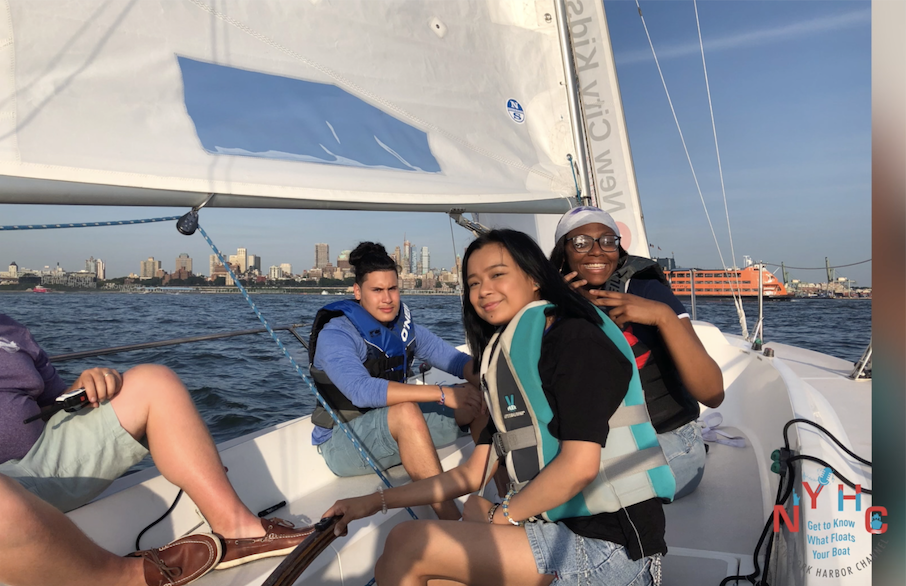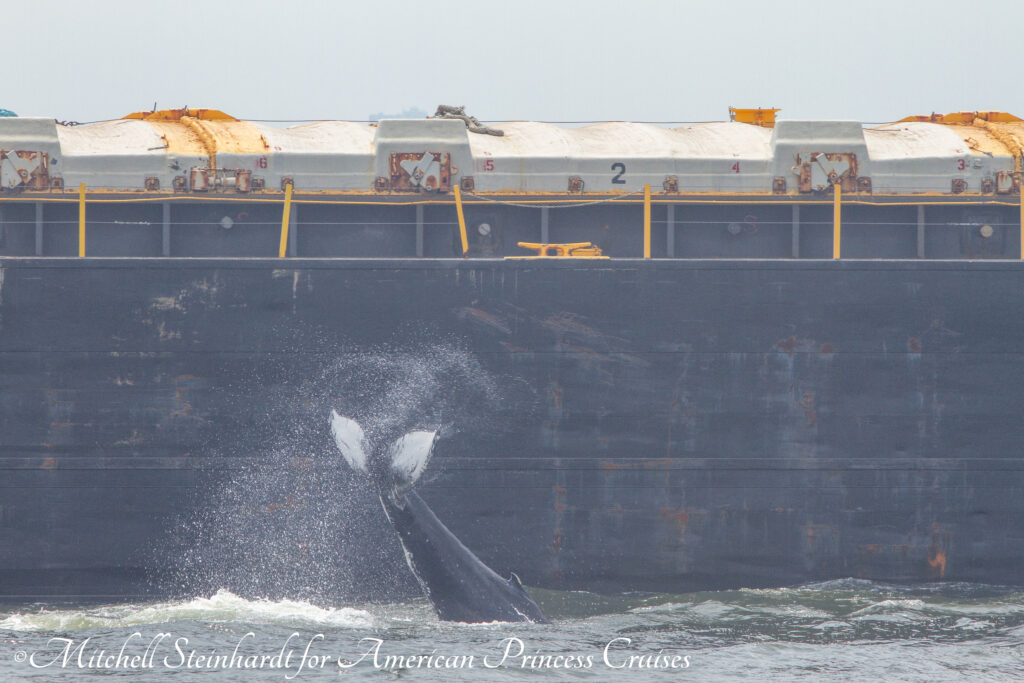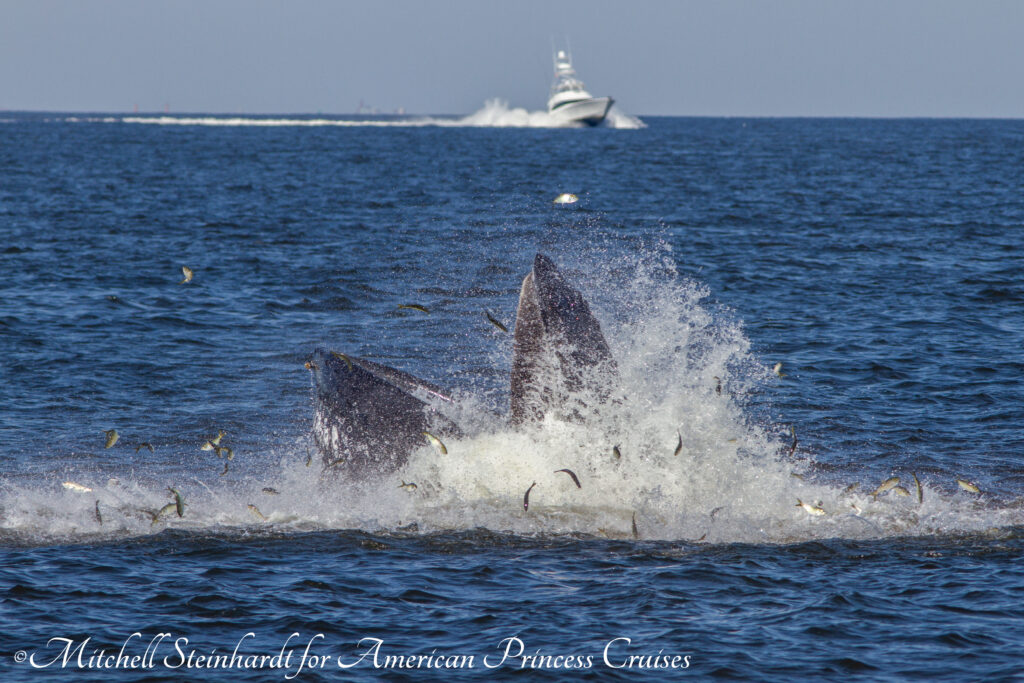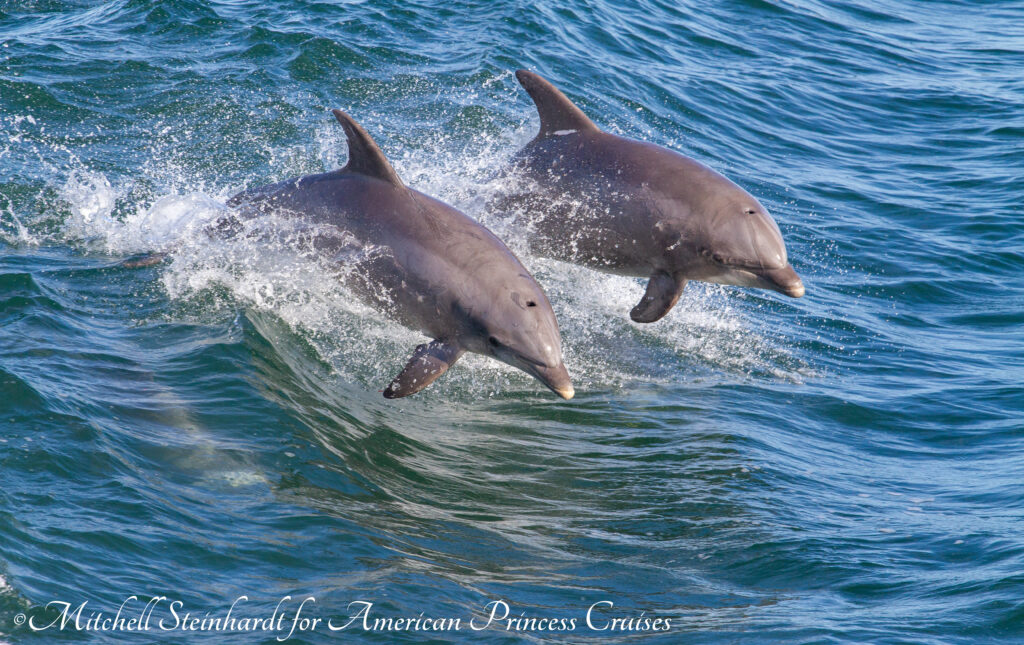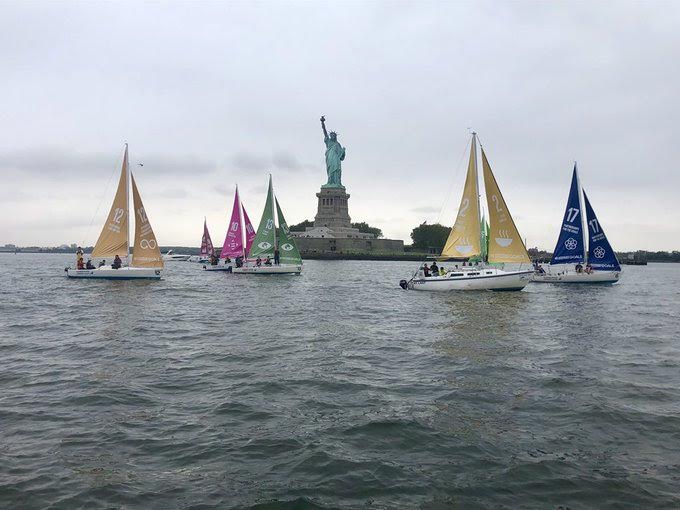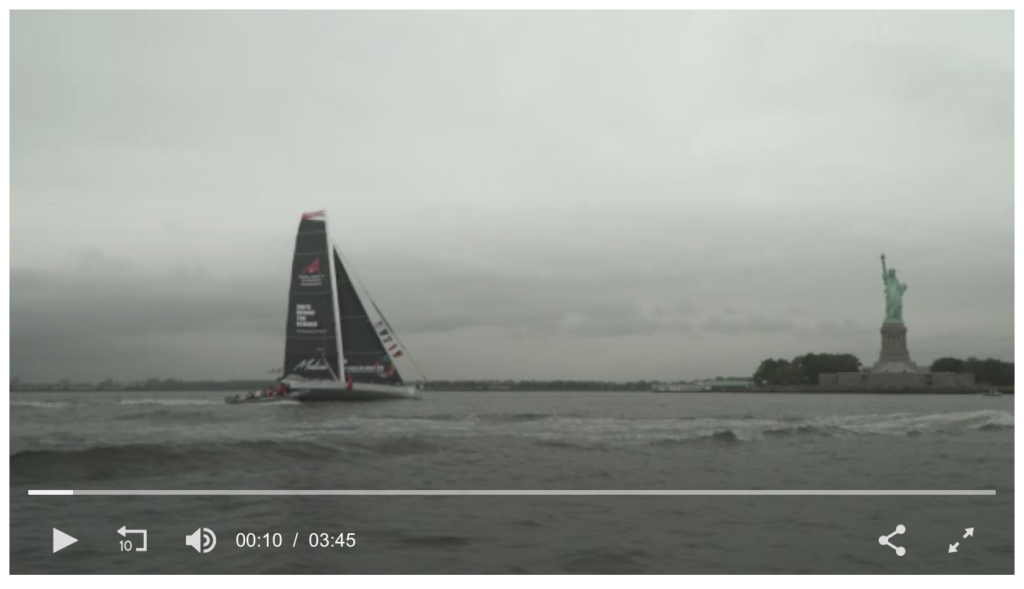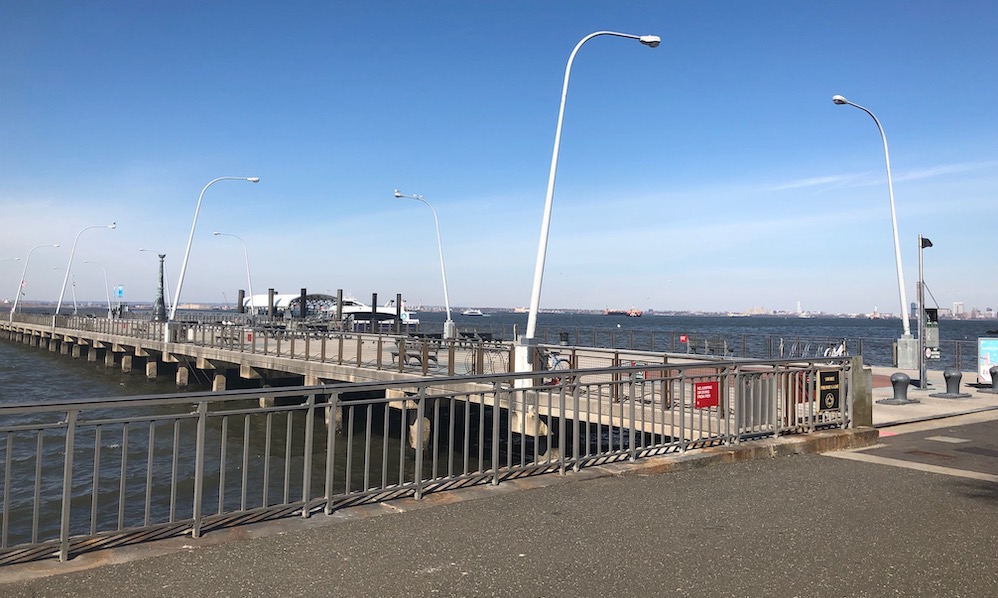The post Shark Research in the New York Bight with Dr. Craig O’Connell appeared first on New York Harbor Channel.
]]>New York Harbor’s “front yard”, the New York Bight is defined by the Atlantic Ocean waters and the ocean floor stretching from New York Harbor east to Montauk, and south to Cape May, New Jersey. It is home to the Hudson Canyon, a subterranean formation more than a mile deep. Recent exploration by NOAA and other marine research organizations have catalogued previously unknown species living in the dark depths. Deep corals are but one of the exciting discoveries in the canyon.
The New York Bight will soon be home to New York State’s first wind farm that is set to start construction just months from now. The foundations of the wind turbines will add dozens of new artificial reefs that will support the Bight’s ever-growing ecosystem. Rhode Island’s wind farm is already proving to be a haven for marine cultures as fishing boat charters will attest.
Whales, sharks, and other sea mammals are now in abundance as global warning is changing sea migration and feeding habitats. For those of you interested in learning first hand about the various species occupying the New York Bight, there are many marine programs available. There are a growing number of naturalists who work on our whale watching vessels. Volunteers are always welcome to join sea rescue organizations and our local aquariums also host educational outreach. Scholarships and internships are attracting budding young marine biologists to attend new programs.
There is no doubt the New York Bight is benefiting from the changes occurring in the Atlantic Ocean. As Scuba diving, fishing charter boats, day cruising, and other water activities grow in popularity, science will continue to discover life in the migratory routes, breeding grounds, and ocean nurseries in our marine environment.
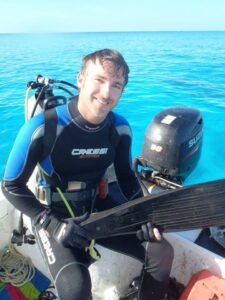
Dr. Craig O’Connell is the founder and executive director of O’Seas Conservation Foundation, Inc based in Montauk, along side his wife, Dr. Nicole O’Connell. The nonprofit foundation focuses on researching different species of sharks through camera studies, bycatch reduction technologies, and underwater video surveillance. O’Seas Conservation Foundation also runs a program called “Shark Camp” which educates and inspires High School students to learn many of the basics of what a Marine Biologist does. Beyond O’Seas, Dr. O’Connell is a nature presenter for Discovery Channel’s Shark Week and an adjunct professor at UMass Dartmouth. He’s also a published author and has won numerous awards for his photography.
I had the privilege of interviewing Dr. O’Connell to get his insight on the upcoming 2021 Shark research in the New York Bight along with finding out more about his O’Seas Conservation Foundation. It went as follows:
Marc: I remember reading your interview with Newsday last summer that you observed many young Whites in the New York Bight. Can you explain if there is a difference between White Sharks and Great White Sharks?
Craig: White sharks and great white sharks are the same thing. The media likes to refer to them as great white sharks, but the true common name here in the USA and other locations is ‘white shark’.
Marc: Please elaborate on how the Bight might become a new breeding ground for the White Sharks.
Craig: There is a big difference between breeding grounds and nursery grounds. The New York Bight is a white shark nursery ground. This was discovered by scientists many years ago; however, our team is working to learn more about this nursery ground so we can find ways to better protect the area and the sharks. Now, the breeding ground – that is another exciting thing that many scientists all around the world are trying to locate. Where are these white sharks breeding? There are two known accounts of fishermen observing white sharks breeding; however, there are no photos and videos from these observations. Therefore, many are still on a quest to film the behavior and learn more about the process. Does the entire North Atlantic white shark population breed in the same location, I really don’t know but would hypothesize that it happens over a very broad area, which is why it is so difficult to observe.
Marc: Why do the older Whites still migrate north while leaving their young behind in the Bight if there is an ample food source for them in the Bight?
Craig: Good question. There is ample food for the young-of-the-year (cool term for white shark pups that are less than a year old) and juvenile white sharks, including small fish (mackerel and menhaden), skates, rays, and smaller sharks. However, as sharks age their diet changes (this is called an ontogenetic shift in diet) and they begin to prefer larger and more energetically beneficial food items, such as marine mammals. When the white shark pups arrive in Montauk, the adults are making their way north (e.g. Cape Cod) to feed on seals (and other prey species).
Marc: What projects will the O’Seas Shark Camp enthusiasts be working on this year?
Craig: We are actively conducting a variety of projects at O’Seas. Projects include bycatch reduction technologies (e.g. technologies that aim to reduce unwanted catch from commercial fishing gears), camera surveys to study shark species diversity with baited remote underwater video systems (aka BRUVS), acoustic tagging research that aims to learn about the long-term movements of a variety of shark species that call Montauk their seasonal home, and FinCam technology research (cameras that we temporarily place on sharks so we can learn about their movements, habitat preferences, and feeding behavior).
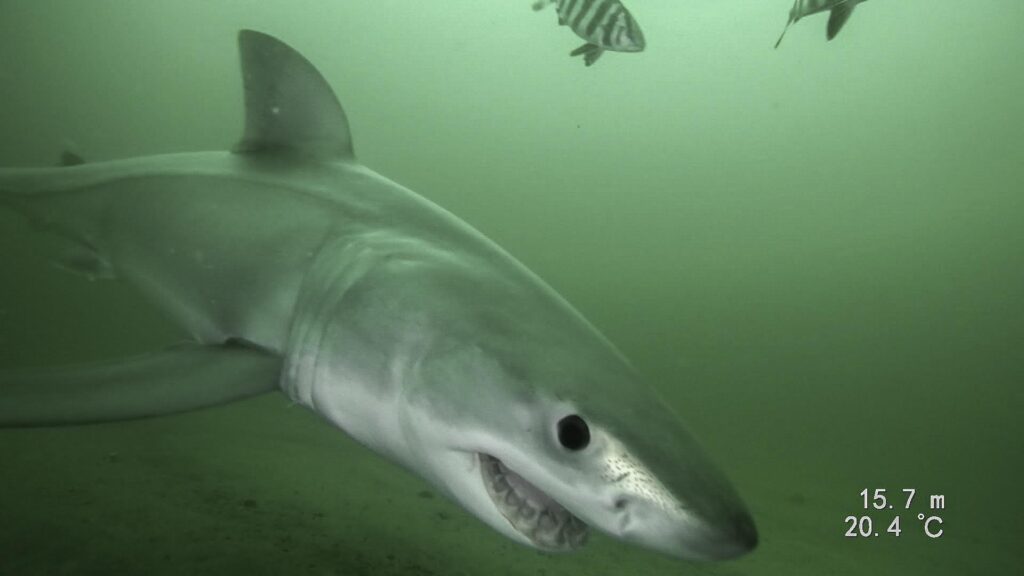
Marc: Do they get involved in tagging and data collection?
Craig: Yes. Our non-profit strives to educate and inspire the next generation of scientists, conservationists, and biologists. Therefore, we feel that the best way to do this is to get them directly involved in our research efforts. In fact, we run a week-long program throughout the summer known as ‘Shark Camp’. During this week, 9th-12th grade youth from all over the world take part in our work and learn many of basics of what a Marine Biologist does. They participate in activities from boat driving to tagging baby white sharks – so it truly is a one-of-a-kind experience. Nothing quite compares to when one of our students sees a large shark for the very first time – their face lights up and you immediately know they are “hooked.” It is our goal to ensure they have the best experience possible and thus far, our program has been such a huge success and we are grateful to all the support we have received thus far.
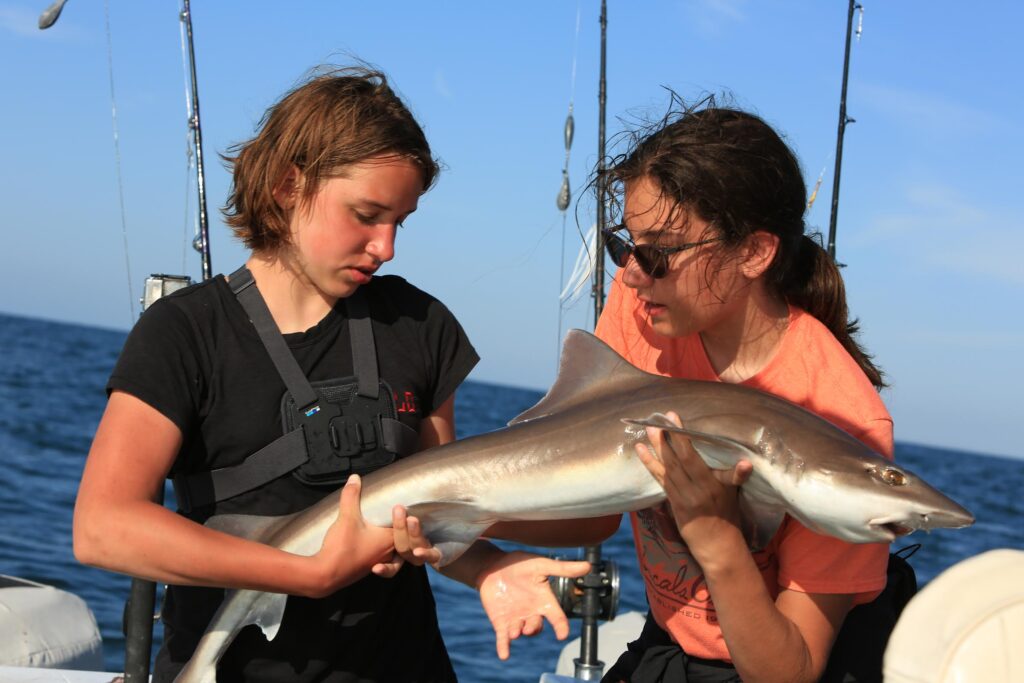
Marc: Does the foundation recruit middle or high school age students from New York City for O’Seas’ youth education programs?
Craig: Yes, we try to recruit high school students from all over the world. In fact, we have had students from Singapore, Indonesia, Costa Rica, Canada, and from all over the USA. Our original goal for O’Seas was to raise sufficient funds each year so that this summer ‘Shark Camp’ can be a free experience for 9th-12th grade youth. More specifically, we hoped to raise sufficient funds to provide full-ride ‘Shark Camp’ scholarships to underprivileged children whose families may not have the necessary means to participate in these types of activities. While we haven’t been successful in raising sufficient funds to meet this original goal of a fully funded ‘Shark Camp’ program (e.g. scholarships for all participants), there have been some truly amazing and generous families that have donated to our organization so we can provide up to 5 full-ride ‘Shark Camp’ scholarships each year for the past several years.
If you would like to read more about ‘Shark Camp’ – please check out our website: https://www.oseasfdn.org/shark-camp-cg0o
Should anyone be interested in helping to fund future campers and fund our research, we are actively accepting donations via email or our website: https://www.oseasfdn.org/donate-c1f8a
Marc: Do your education programs also teach its students about ocean mammals such as the North Atlantic Right Whales that are of course critically endangered but often observed off Long Island? I would like to learn more about the relationship between whales and sharks in the New York Bight.
Craig: There are weeks of ‘Shark Camp’ where whales and dolphins are so numerous that no matter where we look, you will see some type of marine mammal. Montauk is truly a special place and even though we focus our efforts on sharks, we absolutely take every opportunity given to us to learn about any types of nature we encounter while on the water. We have never encountered a North Atlantic Right Whale, but we have encountered bottlenose dolphins, common dolphins, humpback whales, minke whales, and fin whales. During certain weeks in the summer, the pods of Atlantic Menhaden (what is known as the fuel of the NY Bight) arrive. This is a preferred prey source for a variety of marine mammals and sharks. During the right time of year, we often look for the pods, keep a reasonable distance away, and watch the humpback whales feed. It is a true treat for everyone involved.
Marc: Does one hunt the other and if so, what species?
Craig: Based on where we are located, we won’t normally see any shark-whale predatory events; however, if we expand the term to marine mammals, it is possible that we could witness some predations between larger white sharks and dolphins or seals. During certain times of the year, the larger white sharks pass through and they most certainly can take advantage of all the prey (harbor seals, grey seals, bottlenose dolphins) that calls Montauk home.
Marc: It has been reported that Orcas are making their way down to Cape Cod and possibly Montauk. As climate change continues to alter the ocean environment, do you see a possible collision between great Whites and Orcas in the North Atlantic or even the New York Bight? I am fascinated by the Orca hunting behavior that has been reported off California or along the coastlines of Australia and New Zealand.
Craig: Global warming is having quite a large impact on marine and terrestrial wildlife all over the world. However, I’m not too sure Orcas will call Montauk home any time soon. Is it possible that they may be spotted on very rare occasions in the future, sure.
Marc: Do you also focus on other species?
Craig: While we focus some of our efforts on white sharks, we work with a variety of other shark species in the New York Bight. More specifically, we work with blue sharks, shortfin mako sharks, dusky sharks, common thresher sharks, and sandbar sharks. What’s important to know is that some of these sharks are experiences huge population declines, therefore, our research is becoming more and more important. For example, the shortfin mako shark is a recreationally and commercially sought after species. Due to this, their populations have plummeted on a global scale and this species is now considered endangered. With continued exploitation, this species may go extinct in our lifetime. Therefore, we must do all we can to protect this species (among many others) if we truly want a healthy ocean for many generations to come.
NYHC will follow and report the research from O’Sea’s base camp in Montauk. No doubt the Shark Campers will have great tales to tell as they explore life in the New York Bight!
The post Shark Research in the New York Bight with Dr. Craig O’Connell appeared first on New York Harbor Channel.
]]>The post IF YOU LIKE MANHATTAN, YOU’LL LOVE MENHADEN (for fishing around NY Harbor) appeared first on New York Harbor Channel.
]]>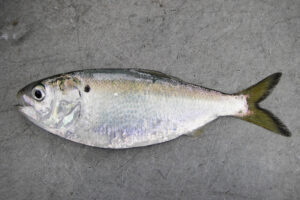
The most desired bait for fishermen of Long Island and New Jersey is known as bunker. Bunker is a colloquial name for the species known as the Atlantic Menhaden. Menhaden is a forage fish that is essential for the ocean food web. Unfortunately for them, every larger fish and mammal swimming in the New York Bight (the sea east and south of New York Harbor) thrive on Menhaden. Local fishermen are disturbed to hear that bunker numbers in the Bight diminish because of industrialized fishery as it has a direct correlation on the number of larger game fish populating their favorite fishing spots. Earlier this decade, the decline was especially traumatic.
However, with warmer waters over the past five years, there has been an uptick in the menhaden population. As climate change has moved Caribbean and Gulf water species northward, the entire ecosystem has also shifted in this northerly direction up the U.S. coastline. Most significantly, lobsters off New England have moved into Canadian waters to find the cooler temperatures on the ocean floor. Recently, warm-water sharks typically abundant off of Florida and the Carolina’s are now visiting Long Island. Of course, another contributing factor is that the sharks may be following the greater numbers of menhaden migrating up to New York and New England.
As a result, Americans are getting their lobsters from Canada, tuna fishing boats coming out of Montauk are filled to capacity, and the incidence of shark sightings are breaking records along Long Island beaches.
WHALES LOVE MENHADEN
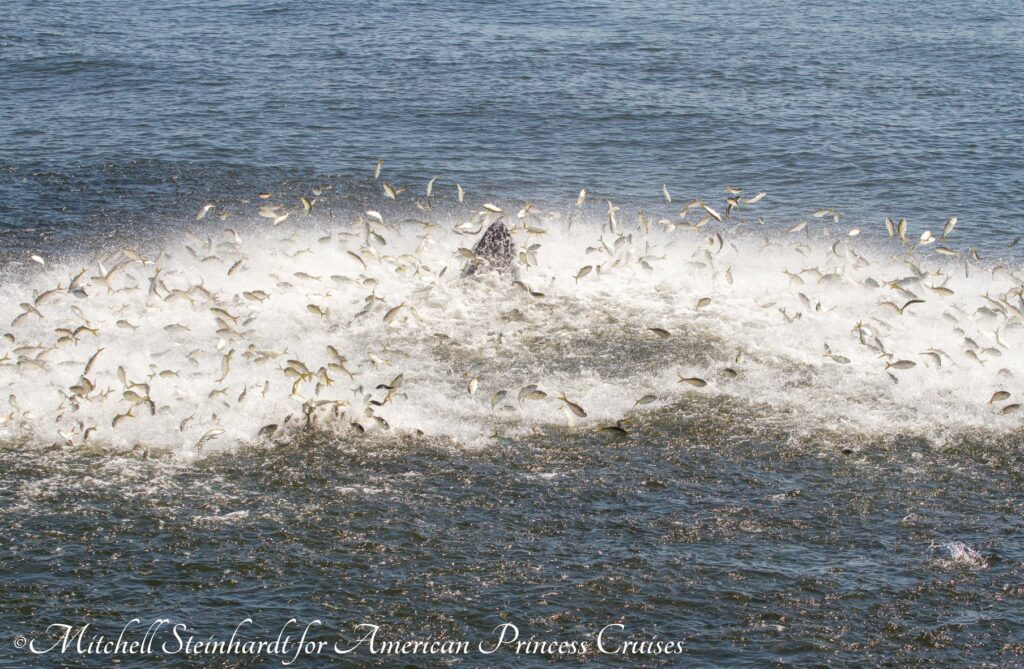
The whale population in the New York Bight has also been on the increase. More humpbacks are regularly feeding on menhaden. The presence of whales outside of New York City is now commonplace and it is no longer seasonal. Monitoring devices such as the Melville buoy built by the Woods Hole Oceanographic Institute identify humpbacks, sei, fin, and right whales throughout the year.
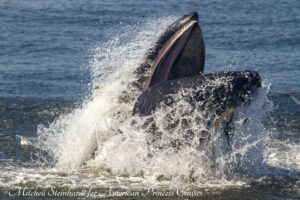
Finally, just three weeks ago, the American Princess whale watching tour was permitted to re-open as Covid-19 restrictions were lifted. Gotham Whale is a not for profit organization that routinely accompanies the American Princess into the New York Bight to catalog all ocean mammals. Their naturalists are happy to report many sightings so far this year.
THE MENHADEN SLAUGHTER IN THE NEW YORK BIGHT
But there is a war taking place in the waters along the United States East coast. For most of us living in the metropolitan area, we know little about it. The Atlantic Menhaden has been a staple bounty for one specific company whose trawlers come out of Virginia to cast their nets into the New York Bight. The Omega Protein Company, part of a conglomerate owned by Cooke, a Canadian firm, is responsible for removing millions of menhaden from our waters every year. Menhaden is targeted as it accounts for the greatest source of omega fish oil, livestock feed, and other desirable consumer goods. The main use is for feed for Cooke’s fish farms around the world.
When New York Harbor Channel first interviewed Paul Sieswerda of Gotham Whale three years ago, we learned of his organization’s effort to not only catalog ocean mammals, but reduce the menhaden fishing quota presently allowed by the Atlantic States Marine Fisheries Commission. Like all commercial operations that rely on government regulations, the Menhaden Fisheries Coalition has at least two dozen large ocean fishing companies within its ranks. This organization has traditionally lobbied and influenced the governing body to allow an excessive slaughter of menhaden.
GOTHAM WHALE PETITION TO STOP THE OMEGA FLEET
For casual fishing enthusiasts, divers, boaters, and admirers of the sea, it is important to get involved to protect your environment. Establishing a manageable program for forage species of fish is essential. You can sign any number of petitions that have been circulated to help maintain a healthy menhaden population in the New York Bight to allow the ecosystem to thrive. Gotham Whale is dedicated to the sea life that calls the New York Bight home. Here is the link for Gotham Whale’s petition to stop the Omega Fleet from over-fishing our waters.
Gotham Whale is aligned with other ecological preservation groups to prevent the collapse of the species in northern waters such as the Menhaden Defenders. The national organization called the Theodore Roosevelt Conservation Partnership (TRCP) is also concerned with saving the menhaden, with greater emphasis this year in the waters outside the Chesapeake Bay where the fight for menhaden is just as important. TRCP lobbies to influence reduced caps and put in place Ecological Management that will consider the impact on other species by fisheries managers.
These alliances will hopefully bring greater weight to the fight within this decade. In doing so, ocean mammals will no doubt flourish in New York waters and more of us will be able to share their magnificence just outside of New York Harbor. The ask of Gotham Whale is to establish a prohibition of industrialized fishing for menhaden within twenty miles from New York Harbor, an area where we know whales feed. A small step to keep a healthy ecosystem in the New York Bight.
The post IF YOU LIKE MANHATTAN, YOU’LL LOVE MENHADEN (for fishing around NY Harbor) appeared first on New York Harbor Channel.
]]>The post City Sail Preps for Virtual Classes on Teaching Children How to Sail appeared first on New York Harbor Channel.
]]>
City Sail’s Director, Soo Kim, has assembled three former students to Captain the Class of 2020. With covid-19, you can imagine the challenges of teaching 32 teens. So the decision was to create a virtual classroom that the students would learn the basics on the City Sail YouTube channel. Once the students learn the ropes online, they will be ready for small, safe groups to take their knowledge onto the boats and sail the harbor with the instructors at the helm.
New York Harbor Channel was fortunate enough to capture Soo and his instructors at the New City Kids facility in Jersey City as the virtual online videos were being produced. The tutorial videos are currently being viewed by the students and their time to board the sailboats is fast approaching. City Sail has one Colgate 26′ and the rest of the craft are donated by local boat owners who are happy to offer their time and resources.
Get to meet the sailing team and hear their pride as they tell their own personal success stories during our interviews. You will be pleased to know that New City Kids all participate in their acclimated music program. These sailors take their music on the water and the water feeds their inspiration to create musical compositions. Take a listen! If you happen to be around the harbor this month, don’t be surprised to hear a impromptu concert as the students tack their way into a bright, healthy future!
We wish you fair winds and following seas, Class of 2020!
The post City Sail Preps for Virtual Classes on Teaching Children How to Sail appeared first on New York Harbor Channel.
]]>The post HOW THE UNITED STATES CELEBRATED INTERNATIONAL HYDROGRAPHY DAY appeared first on New York Harbor Channel.
]]>The word ‘Hydrography’ means underwater mapping. This one hundred year old institution grew from the 16th century explorers of the New World. Each ship brought cartographers with them so the maps would prove the existence of a new claimed territory. Of course the map served to make return trips possible by identifying landmarks and bodies of water as well as marking dangerous locations and hazards.
The earliest tools of measuring the depth of bodies of water was a piece of stone or lead tied to a string. Early civilizations like Ancient Greece or Nordic Vikings used measurements for their ports, but it took the British Royal Navy to establish the position of Hydrographer of the Navy in 1795 to standardize the depths of the most traveled coastlines. The term ‘fathom’ was used by the British Admiralty in 1801 as six feet of rope or cable.
Not to be outdone, the U.S. Depot of Charts and Navigation was formed. It was headed by Commander Matthew Maury in 1825. Commander Maury’s work is the inspiration and precedent for the creation of the U.S. Navy’s Navoceano department. NYHC was privileged to interview the Navy crew as well as the civilian scientists working on USNS Maury in 2018 as it’s latest multibeam sonar and ROV’s were used for coastal hydrographic surveys.
NINETEENTH CENTURY WESTERN LITERATURE CAPTIVATED BY THE DARKNESS OF THE OCEANS
In 1871, a French novelist was awestruck by Commander Maury’s findings. Jules Verne must have fantasized about submersible underwater vehicles as he wrote his famous novel ‘Twenty Thousand Leagues Under The Sea’. You get the impression from the title Verne might be referring to the depth of the ocean; however, this still was not possible as ocean depth measurement was still in its infancy. Instead, twenty thousand leagues is the total distance traveled by Verne’s character, Captain Nemo and his crew aboard the fictional submarine, Nautilus. The number of leagues translates to 80,000 kilometers, almost twice the circumference of the earth.
Back in the United States, the North Atlantic spawned Herman Melville’s ‘Moby Dick’. This novel brought a monsters of the deep into reader’s bedrooms as the world slowly learned about the creatures who would magically surface only to dive to its depths once again. Captain Ahab’s unwavering pursuit of the famous but probably fictional ‘white whale’ as Beluga whales of the Arctic are white, but they are not the colossal size capable of capsizing a whaling ship.
The depths of the world’s oceans would remain a place of mystery especially to those who traveled it frequently. The love of trans-Atlantic voyages would occasionally pull vessels to the ocean’s floor. Newsreel features showed seasoned passengers on Ocean Liners such as RMS Titanic swallowed by mishap. Who could imagine an iceberg sinking a ship?
THE WORLD BEGINS TO MAKE SENSE FROM OCEAN SCIENCE
International political turmoil prevented uniformity in ocean transit and measurements. Finally, in 1921, there was an effort to establish consultation between national governments for safe navigation, technical standards and the protection of the marine environment. The world’s waterways did begin to follow common guidelines as coastal surveys became the norm for international shipping.
The second half of the 20th century developed submarine technology that spawned manned and unmanned submersible vehicles that descended to the depths of the ocean collecting digital hydrographic data. The French explorer, Jacques Cousteau, made for spectacular television viewing in the 1970’s with weekly episodes of underwater scientific adventures. For those of us who watched his series, Cousteau opened our eyes to the discoveries of his exploration team members and the instruments that seemed to roll out of production on a weekly basis. The Cousteau Society mission has found itself alive and well today in Fabien Cousteau, Jacques’ grandson, as he pioneers underwater habitats that may be the predecessor of cities of the future.
Planet Earth’s new frontier is the ocean floor as it is now as popular as space exploration. Fifteen years ago, the United Nations hosted the member countries of the modernized initiative called the International Hydrographic Organization (IHO). The UN assembly adopted a resolution for the entire planet to celebrate World Hydrography Day every June 21st. This year’s theme is “Enabling Autonomous Technologies”. Next year, 2021 will mark the one hundredth anniversary of the creation of the original Hydrography Organization that was comprised of multiple nations around the world.
THE U.S. CHAMPIONS OF HYDROGRAPHY ACKNOWLEDGE INTERNATIONAL HYDROGRAPHY DAY
Aside from the U.S. Navy’s Navoceano program, the most dedicated agency is the National Oceanographic and Atmospheric Administration (NOAA). NOAA is divided into various sectors of study. Meteorology is most visible as it deals with weather and weather events such as hurricanes. NOAA also operates its Fisheries sector and it includes the Ocean Exploration and Research (OER) branch.
OER’s newest hydrographer, Dr. Sam Candio, paid homage to the IHO on International Hydrography Day. He mentioned sonar devices are helping define the marine world, but only one fifth of the ocean floor is mapped. He looks forward to being a key player in NOAA’s participation of this exciting frontier.
The IHO gives the world an opportunity to pull back the curtains and reveal each country’s self-serving interests in hopes of incorporating them into a shared, glorious, global plan. The world oceanographic industries do have a reason to celebrate. Measurements will not be propriety. Everything will be shared. The cost of technology is shared.
U.S. NATIONAL MARITIME DAY IS CELEBRATED ON MAY 22ND DRIVING THE NEED FOR HYDROGRAPHY
In 1933, the U.S. Congress created a national holiday that honored the first U.S. steamship to make a trans-Atlantic voyage in 1819. Holidays such as these strengthen a sense of national pride, however, they do little to allow international efforts, blinding us to see the larger picture taking place on a global stage.
The United States carefully watches the shipping activity of its ports. International container goods shipped around the world is approximately 1.8 billion metric tons. With these kind of numbers, Is environmental protection the driving force behind measuring the ocean depths? Well, yes it can. Advocacy groups have helped shape the establishment of dozens of government agencies that do protect marine ecosystems and sea life.
The Obama Administration created Monuments as protections of fragile habitat zones and established marine sanctuaries; however, the Trump Administration is striping those protections. Preservation advocacy groups convinced the Obama Administration to mandate the Environmental Protection Agency (EPA) to strictly regulate fishing and exploration in the entire Northeast Canyons and Seamounts Marine National Monument (NCSMNM) area as it was recognized to be a spawning ground for species essential to supporting and sustaining marine life along the North Atlantic coastline.
If the present U.S. administration has it’s way, this apparent romantic notion may be outweighed by the greater force of marine commerce and the exploitation of natural resources under the ocean floor. It must also be noted that this administration has no desire to actively participate in the IHO as the President clings to an ‘America First’ decree. There is not a single American in the IHO executive committee. The future is a shimmering stardust in the specter of autonomous transportation initiatives. Somehow, NOAA scientists hang on to the dreams and desires of the past administration.
NOAA SOON TO ENTER ITS THIRD DECADE OF DEEP WATER EXPLORATION
As the world is increasingly comfortable with operating submersibles, ROV’s are entering uncharted regions in record numbers. Not only are military and governmental agencies lowering these essential automated tools into the oceans, private foundations and commercial industries are busy at work on a multitude of missions. NOAA’s Ocean Exploration and Research (OER) is quickly logging two decades of exploration data.
What was NOAA’s closest deep sea exploration to the U.S. Eastern coastline? New York City should be proud to know that less than one hundred miles southeast of the Verrazzano Bridge, the Hudson Canyon Expedition was successfully mapped and researched in 2002. Dr. Peter Rona, then a professor at Rutger’s University, was lead scientist aboard the NOAA Exploration ship, Ronald H. Brown. High definition cameras caught images of the canyon floors revealing deepwater corals, sponges, and species never before seen. The depths of the canyons fall three miles below the surface of the New York Bight. Seismic reflection profiling was used to map the canyon. Since then, this controversial method has become a major subject of protest by environmental advocacy groups. Seismic blasting has given much evidence of the harm it causes to marine mammals and the ecosystem in general.
BATHYMETRIC DATA COLLECTION SPAWNS A DOZEN ACRONYMS TO ACHIEVE ONE GOAL
Over the past decade, multiple data-collection programs created multiple data results. With one fifth of the earth’s ocean bottom mapped, the end-product is questionable. Nonconformity has obvious flaws when it comes to science. The IHO is spearheading the international effort to conform to one agreed protocol for all to standardize the methodology and instrumentation.
ASPIRE is the acronym for the Atlantic Seafloor Partnership for Integrated Research and Exploration. A centralized, shared protocol to unify independent underwater data acquisition and established qualified and quantified databases of the ocean floor. The Galway Statement has successfully joined forces between the United States, Canada, and the European Union nations to initiate programs in the North Atlantic to do just that.
Another collaborative initiative is called Seabed 2030 to standardize and furnish authoritative data available to everyone. It’s goal is to help make policy decisions based on the bathymetric information. NOAA’s National Centers for Environmental Information (NCEI) division data base is already accessible to agencies and the general public.
ASPIRE and Seabed 2030 are foundations of NOAA’s latest hydrographic study as it is tackling the deep canyons of the North Atlantic.
TWENTY PRIORITIES RESULTING FROM THE 2018 CALL FOR INPUT WORKSHOP
On November 16th, 2018, NOAA summarized their Exploration Science Planning Workshop. The “Call for Input” netted 50 deep sea experts to discuss their ideas and concerns for regional exploration priorities in the Mid-Atlantic Ridge. Here is the summary of twenty exploration subjects planned for the 2019 & 2020 expeditions….
1. Marine mammal habitats
2. Water column exploration for Beaked whale feeding and spawning grounds in seeps of the Northeast Canyons and Seamounts Marine National Monument (NCSMNM)
3. North Atlantic Right Whale transit in the Laurentian Channel
4. Seeps in the Laurentian Fan
5. A proposed marine park in the Laurentian Fan
6. Fisheries and benthic habitat assessment in the Halifax Line
7. Unknown fauna of The Gully
8. Unknown canyons
9. Submarine landslides in the Laurentian Fan.
10. Geohazards
11. Deep-sea coral and coral conservation areas
12. Sponges in the Seamounts
13. Deep-sea mining interests
14. Fisheries habitats and interests
15. Underwater Cultural Heritage surveys
16. Shipwrecks offshore of Boston and New York
17. USCGC Bear search with high-resolution mapping using AUV
18. Cold-water coral communities in the Gulf of Maine
19. Partner with existing marine geophysical surveyors for oil and gas exploration in the Grand Banks and Flemish Cap region. Multibeam bathymetry coverage for critical mineral inventory initiatives.
20. Resurvey of the RMS Titanic using new archaeological devices and methods.
THE NOAA OCEAN RESEARCH VESSEL, OKEANOS EXPLORER
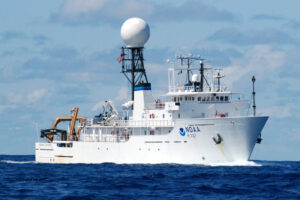
Okeanos Explorer’s home port is North Kingstown, Rhode Island. It utilizes the latest exploration tools such as multibeam sonar, telepresence, water column investigations, and underwater robotics. Two Remotely Operated Vehicles (ROV) submersibles on Okeanos are Deep Discovery and Seirios. According to NOAA’s OER, Okeanos is “the only federal vessel dedicated to exploring our largely unknown ocean for the purpose of discover and the advancement of knowledge about the deep ocean.”
THE 2019 EXPEDITION ONE HUNDRED MILES FROM MONTAUK
Ground Zero for residents of the Mid-Atlantic and Northeast region of the United States, is the Northeast Canyons and Seamounts Marine National Monument (NCSMNM). NCSMNM is 5,000 square miles of underwater terrain and it is as deep as the Grand Canyon. It sits 100 miles south east of Cape Cod and Montauk Point. This deepwater sanctuary remains mostly unexplored. Thanks to NOAA, here are some Images of the submarine breathtaking landscape from the Okeanos Explorer study.
Two of the 2019 Okeanos Expeditions were called “Deep Connections” and “Windows To The Deep”. They featured Biodiversity hotspots as it proudly broadcast the existence of Bubblegum Coral in Gully Canyon during one of its many live NOAA webcasts. Other webcasts allowed the NOAA audience to watch as the ROV slowly examined the face of a sheer cliff wall with no variance, truly a massive Massive. The Okeanos crew repeatedly mentioned the beauty that has no boundaries between the borderlines that separate Canadian waters from the Untied States. The underwater regions are seamless as the ecosystems expand and transit beyond the man-made boundaries above. This is a stellar picture of hope and optimism.
A PARODY OR A PARADOX
NOAA is surrounded by storm clouds. A politically-inspired storm field that is interwoven within NOAA’s very fabric, its very existence. Since 1971, the NOAA emblem clearly stated it is connected to the U.S. Department of Commerce. The DOC is currently headed up by Wilbur Ross, a man who has risen through the ranks utilizing fossil-fuel industries as his backbone. Ironic that the very organization that prides itself as the people’s voice that tries to stop the advancement of fossil fuel reservoirs under the ocean floor is captained by a man whose hands are mired in it. The outwardly visible side of NOAA is glowing with environmentally friendly, science-based, and thought-provoking initiatives intended to lessen fossil-fuel dependency. NOAA Fisheries is a shining tower, the pinnacle of progressive, earth-minded thinking. However, it’s subservience to the DOC cannot be ignored. The powerful mandates that arise from the DOC’s cellars are hypnotic and unquestionable. The paradigm is this. NOAA is all about protection. DOC is all about mass economic undersea mining and self serving plundering of the ocean’s riches.
Meanwhile, the Environmental and Energy Law Program of Harvard University has carefully monitored recent activities that affects the waters not far from it’s Cambridge, Massachusetts campus. Harvard carefully followed President Trump’s executive order #13795 signed into effect on April 28th, 2017 that instructed immediate review by the Secretary of Commerce of the protection of Canyons and Seamounts as it was a watermark of the Obama Administration in 2016. The executive order instructed Wilbur Ross to assess the opportunity costs associated with potential energy and mineral exploration in this area.
It wasn’t long before environmental groups such as Oceana quickly sued the DOC. Using the Freedom of Information Act, Oceana stated the DOC failed to disclose actual initiatives in hopes of forcing the administration to reveal its secretive plans for resumption of offshore drilling and deregulated commercial fishing. This and other lawsuits have sidelined the government’s desire to activate oil and gas surveys. The independent seismic testing vessels were denied operation.
And yet, with all of the drama swirling around within DOC, it was as if Moses parted the sea to allow the single NOAA ship to motor out into the Northeast Canyons and pursue their solo mission in otherwise turbulent political waters. Half of the Okeanos mission was accomplished before the approaching winter of 2019 closed down Okeanos operations. The ship returned to Rhode Island for retrofit and repairs. The samples and data were inspected and the crew sat out the season waiting to resume in April of this year.
AS A PLAGUE SETTLES OVER AMERICA, THE EXPLORATION AND ITS D.O.C. TENTACLES ARE ON HOLD
Okeanos Explorer is halfway through it’s seafloor mapping mission of the NCSMNM. Additional exploration and mapping was scheduled for this August to mid September. Covid-19 has paused the operation until further notice. Once the mission is given the green light to resume activity, the concentration for this year’s survey will focus on the Sohm Plain. Flat ocean bottoms are the kind of terrains of most interest to the oil and gas industry.
Out of the blue, President Trump’s June 5th Proclamation was announced before an audience of Lobstermen representing the Commercial Fishing Industry at the airport in Bangor, Maine. The Proclamation immediately opens the Northeast Canyons and Seamounts Marine National Monument protected area to large-scale trawling. This is the very region that NOAA recently touted its mandate to reasonably manage fishing based on scientific study. It is no coincidence the Proclamation cites a healthy increase in the populations of species that were of primary concern to ensure protection. Neil Jacobs, now famous for his role in Sharpie-gate, has issued a dubious statement claiming the harm to whale species does not rise to “a population level consequence for the species.” Jacobs mouths the Trump administration credo that the United States must be energy independent.
The Fossil-fuel industry supports EPA Secretary Wheeler’s proposal to rollback Obama protections and allow shortcuts for businesses to bypass regulations such as Clean Air Act of 1970 and Climate Change regulations. On the surface, top NOAA officials have unilaterally reversed direction in favor of compliance with other federal administration officials within the DOC. It is an understatement to say the Proclamation overrides NOAA’s carefully formulated plans this year. The light-minded thinkers of NOAA can only wonder how their mission will continue unimpeded as commercial fishing vessels are now allowed to drop their nets into the very depths they are trying to protect.
Just a few weeks ago, a National Strategy for Mapping, Exploring, and Characterizing the United States Exclusive Economic Zone was distributed this month by the President’s Ocean Policy Committee. To the uneducated mind, there seems to be a veiled reference in section 4.2 to “create a market for commercially developed technology applications” with the inclusion of “external partners”. In section 2.1 seabed backscatter acoustic imagery and sub-bottom profiling” is communicated, but seems to be vague. There are methods expressly outlined for ocean floor testing; however, they are not specifically referenced as the only methods currently available or specifically utilized.
Will NOAA be using Passive Acoustic Monitoring (PAM)? The International Association of Oil and Gas Producers funds PAMguard software created by Sea Mammal Research Unit at the University of St. Andrews.
Meanwhile, five seismic testing companies have been green-lighted to perform the controversial mapping method on the Outer Continental Shelf in the North Atlantic. It is no coincidence that just last week, the federal government overruled North Carolina’s case that tried to stop the testing forty miles off the outer banks. This area, known as ‘The Point” is a massive habitat for marine species. The endangered Right Whales and Cuvier’s Beaked Whales are extremely sensitive to the seismic blasting. The Bureau of Energy and Management (BOEM) rescinded its previous decision three years ago in favor of granting the permits.
It is obvious that NOAA continues to operate critical global initiatives with one hand tied behind its back. NYHC has attempted to contact officials at NOAA for comment on it’s policy on seismic testing. We have yet to receive a reply.
SUSPENSE THRILLERS OF THE 1980’S MAKE A COMEBACK
There are two motion pictures that come to mind as we witness the paradox unfolding at NOAA. One is Star Wars Episode V and the other is Hunt for Red October. Both movies offer a psychological window into the schizophrenic drama playing out between the DOC and NOAA. Interestingly enough, the brilliant American actor, James Earl Jones, is in both of them.
I cannot help but hear James Earl Jones’ voice-over for the Darth Vadar character as the haunting black-robed figure wearing a veiled helmet and respirator, menaces, “You don’t know the power of the dark side! I must obey my master.” Can you envision Wilbur Ross standing over a cowering researcher on the gangplank of Okeanos? Lord Vadar pleads with his son, “Come Luke, Come to The dark side.”
Then, in the 1990 movie, Hunt For Red October, James Earl Jone’s character, Admiral James Greer famously says, ” That torpedo didn’t self-destruct, you heard it hit the hull and I was never here!” as the submarine mission takes a solicitous turn of international detente. A meeting inside the DOC could easily adopt this scene.
It is not too far a stretch to align Captain Nemo, Captain Ahab with Admiral Greer and Lord Vadar. Despite their being a century apart, all four of these characters face their inner souls during a critical time in their mission. Hopefully, they choose wisely. We can only hope the same for our cast of characters that hold the future of our seas in their hands.
CONCLUSION
Diving down within the US Economic Exclusion Zone, the haunting question is when is the seabed surveys allowing commercial exploration? Thanks to the virus and the exploration halt, the stoppage has bought some time. Despite, declining call for seismic blasting technology over the past five years, the gas and oil exploration industry continues to develop more sophisticated instruments to enhance the controversial marine geo-physical survey technique. 4D imagery is now available as well as floor mounted devices that can be remotely activated in a field that may require periodic use of seabed inspection.
The meaning of International Hydrography Day is quite simple. It is a moment to recognize the good work the entire world can participate in. It serves everybody. And everybody should be excited by it. The mapping of the ocean floor is a signal of the future. In these times when the world should come together, it should not be taken as a signal that threatens the United States into formulating a self-serving credo.
The post HOW THE UNITED STATES CELEBRATED INTERNATIONAL HYDROGRAPHY DAY appeared first on New York Harbor Channel.
]]>The post WANTED! CITIZEN SCIENTISTS FOR THE GOTHAM WHALE CATALOG appeared first on New York Harbor Channel.
]]>New York City Whales are a reality. Two Woods Hole Oceanographic Institute (WHOI) detection buoys confirm the steady presence of Fin, Sei, Humpback, and North Atlantic Right Whales in the New York Bight, the area just east and south of New York Harbor. This month, humpbacks are ever-present. So much so, sadly, one washed up on Jacob Riis beach. It is suspected to have been a newcomer to the area or at least it was not cataloged in the local marine mammal data base.
Whale watching has become a steady business for the operators of the American Princess based in Far Rockaway. They maintain a regular schedule of whale watching tours where a local naturalist and an apprentice or two are part of the excursion. Their experience and knowledge of sea life in and around the local waters educates the ship’s audience.
One such marine enthusiast is Mitchell Steinhardt. His knowledge of the
local sea life in the New York 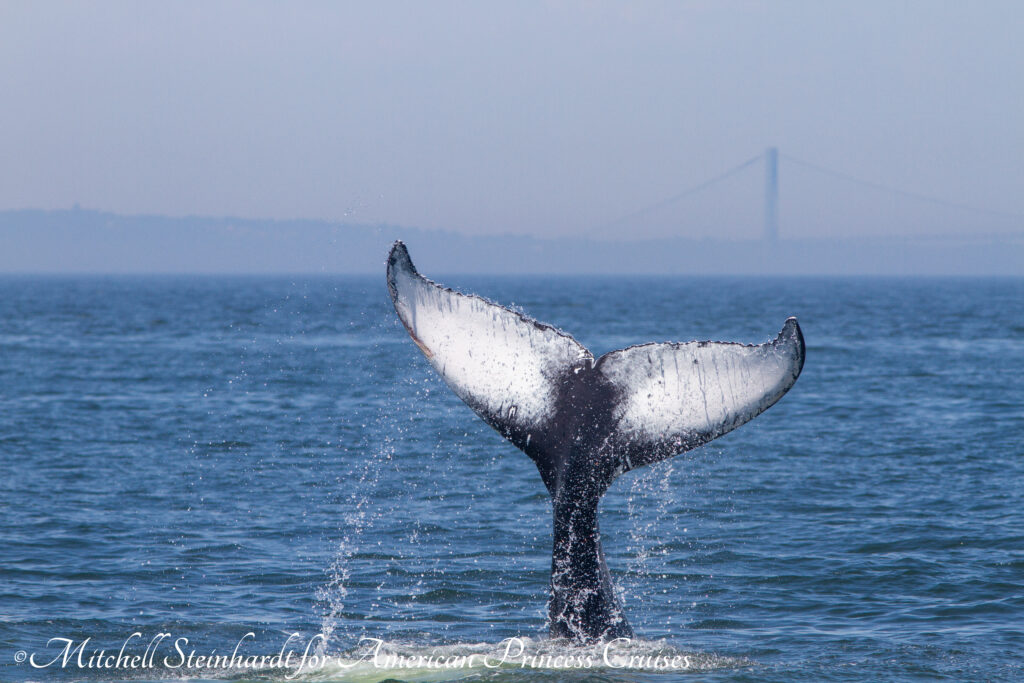 Bight is captured in his photography. But you must understand that the tour is not only for the whale watching experience. The spotting of marine mammals is a science. Photography not only offers the possibility of award-winning pictures, for Paul Seiswerda of Gotham Whale, it is a necessity to keep a catalog viable.
Bight is captured in his photography. But you must understand that the tour is not only for the whale watching experience. The spotting of marine mammals is a science. Photography not only offers the possibility of award-winning pictures, for Paul Seiswerda of Gotham Whale, it is a necessity to keep a catalog viable.

Gotham Whale is a source of education, advocacy, and science for the inhabitants of New York, terrestrial and marine. It contributes to the improving health of New York’s marine environment, for the betterment of both humans and whales. Paul and his team inspect the photos and updates the data base. He catalogs returning friends or better yet, new ones. It’s the new ones that excite him most, as it is a new number or a nickname based on characteristic markings on the fluke, fins, or face kept in Gotham Whale’s New York City Humpback Whale Catalog. Gotham Whale also tracks the numerous seals and dolphins that call New York home.
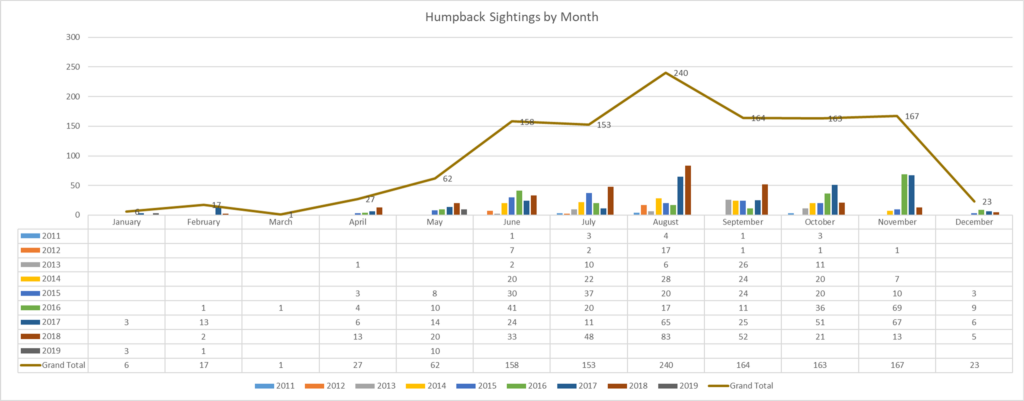
But Covid-19 has temporarily shut down whale watching tours. The American Princess is tied up at the Breezy Point dock. Even if the ship was to re-classify itself as a research vessel, the lack of paying customers would not be enough to overcome the operating cost. The tourists have disappeared. So has Gotham Whale’s main avenue to catalog the New York Bight marine mammals. Paul is worried the entire 2020 Whale Watching season will be cancelled.
CALLING ALL CITIZEN SCIENTISTS!
Gotham Whale must turn to alternative methods to get their data this season. Enter the Citizen Scientist, a hardy marine lover who may be a local kayaker, canoer, sailor, jet-skier, or fisherman. While these adventurous souls are out on the water, there is a good chance they will encounter the very mammals Paul is looking for. This also applies to sea captains of the large cargo and cruise ships as well as the many support vessels that work New York Harbor such as barge tugs.
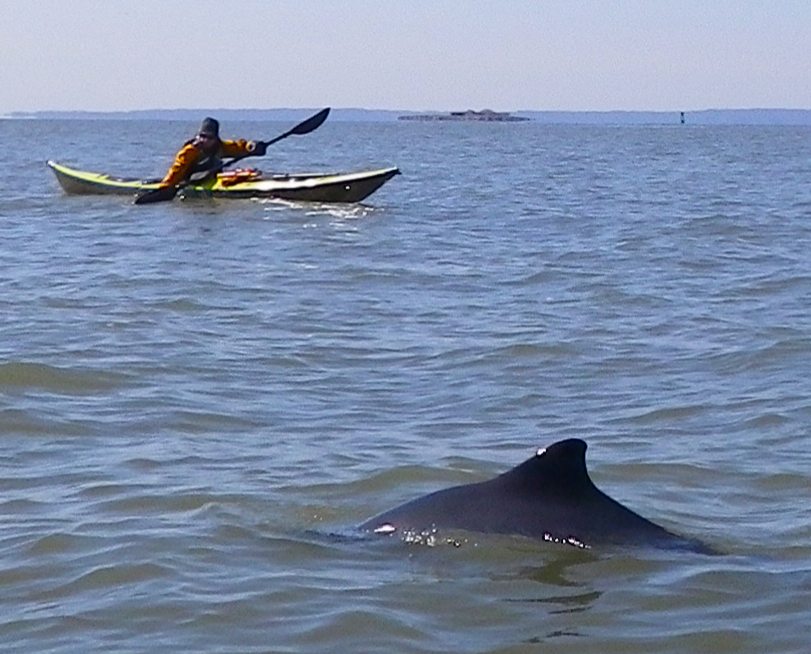
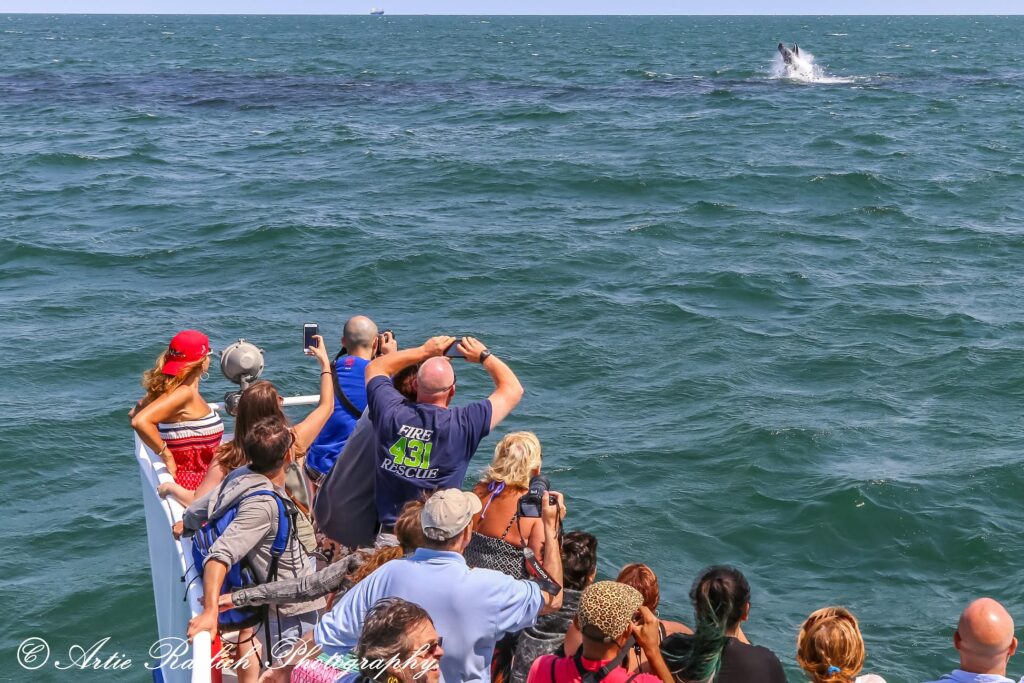
As marine mammals are migratory, it is important to track their movement on a daily basis. New York has recently reopened marinas so the chances are good that boaters will be passing Jamaica Bay, Staten Island, or Sandy Hook. This sea triangle forms the region where whales, dolphins, and seals thrive.
WHAT YOU CAN DO!
You can be Paul’s ‘eyes on the water’. Imagine the excitement of your observation at the time of sighting. Was that whale feeding? Was there a pod of whales? Did you observe a baby calf? Your cell phone automatically gives the latitude and longitude of your location as soon as your picture is taken. There you go… you are already a Citizen Scientist! Welcome to the club!
So Paul is asking any boater to be on the lookout. If you do have an encounter, please send your photo to [email protected]. Not only will you be helping the preservation of these endangered creatures, you will also get a first hand education of what kind of animal you encountered. You will forever be credited with your submission for Gotham Whale’s 2020 catalog. We thank you in advance for doing something special for the waters of the New York Bight.
Gotham Whale is a not-for-profit organization and donations for their tireless work are always appreciated.
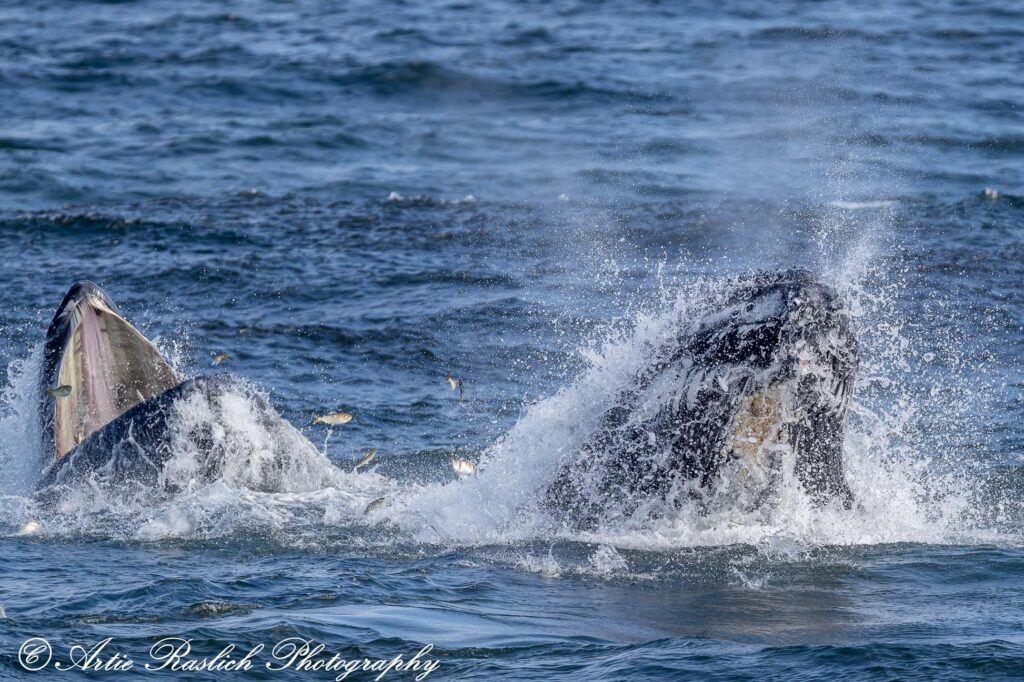
The post WANTED! CITIZEN SCIENTISTS FOR THE GOTHAM WHALE CATALOG appeared first on New York Harbor Channel.
]]>The post Sailors And Seniors Helping Jersey City Homeless During Corona Times appeared first on New York Harbor Channel.
]]>
One day, while driving around Jersey City running errands at the early days of the Covid-19 crisis, Michele Smith-Wiemer and Barry Richards saw many homeless people out on the streets. They decided to take action and help them, especially during the time where there are very few people outside and welfare services are either shutdown or overwhelmed. For the first drive, Michele – who owns a Carver 36 trawler in Liberty Landing Marina – cooked chilli and tortillas at her boat galley. They shared their story and plan with their local community of boaters in the Morris Canal via Facebook and invited other boaters to join them and contribute.
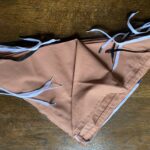
Over the past 6 weeks the donation drive became bigger and bigger and they were able to feed almost 50 of Jersey City’s homeless each Sunday. In addition to food donations they received from their fellow boaters, they started a Go Fund Me campaign that is raising funds to get masks for the homeless as part of an effort to educate them as well as protect them from the pandemic. The masks are being made by seniors, of which are Michele’s Mom Susan Smith and her Oregon retirement community working on sewing masks. Funds raised are helping getting materials – specifically elastic for the masks as well as to cover shipping costs.
The donation drive is happening for the 7th time this coming Sunday, and I will be joining Michele & Barry to collect and distribute food and masks. The goal for this week is to supply 60 meals for the homeless, as well as get more masks supplied.
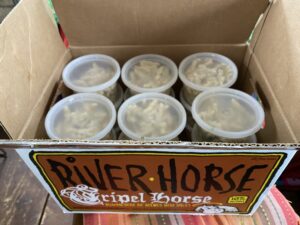
Interested in getting involved and contributing to this effort? Here are ways you can do so:
- Donate elastic and fabrics for mask making
- Donate food – since many homeless have bad teeth – it’s best to donate soft and creamy foods such as: pasta, chilli, curry (not too spicy), rice, chips, bread, cupcakes, canned goods, chocolate and other soft candy
- Contact local restaurants or catering services that are willing to donate meals (we are willing to facilitate coverage of the cost of produce and man power)
- Any connection to postal or shipping services that can provide a quick delivery to Jersey City – as shipments from Oregon seem to take way too long….
- Donate money through Go Fund Me
If you are interested in helping out or have any contacts who might be helpful – please contact Michele at: [email protected]
The post Sailors And Seniors Helping Jersey City Homeless During Corona Times appeared first on New York Harbor Channel.
]]>The post Focus On: Captain Nitzan Levy, Founder of ‘Sailors NYC’ appeared first on New York Harbor Channel.
]]>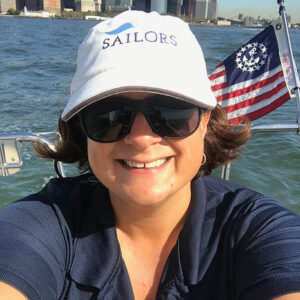
Nitzan is the founder and director of Sailors NYC. She started the company to offer both veteran sailors and novices alike to learn the ropes of sailing and ultimately join as a crew member. Nitzan was interested in contributing her personal stories for our May event that celebrated Walt Whitman’s 200th Birthday. Being a hard-working, hands-on mariner, with much experience of navigating the waters of New York Harbor, Nitzan’s enthusiasm is captured in this recorded audio clip.
The post Focus On: Captain Nitzan Levy, Founder of ‘Sailors NYC’ appeared first on New York Harbor Channel.
]]>The post NORTH ATLANTIC RIGHT WHALE CALVES BORN! appeared first on New York Harbor Channel.
]]>It is calving season! As of this week, three North Atlantic Right Whale calves have been born in the Critical Habitat off the coast of Florida and Georgia. The mothers do not have names, rather they are known as #1204, #2791, and #3317.
Katie Jackson of the Florida Wildlife Commission is familiar with all three females. These whales have given birth multiple times over the past decade. #2791 is at least 22 years old and this is her third known calf. But many more calves are needed. According to Dr. Charles “Stormy” Mayo of the Providence Center for Coastal Studies, at least one hundred of the remaining Right Whales should also be capable of producing offspring this winter. He remains guarded and hopes for the best to avoid possible extinction of the North Atlantic Right Whale that could happen within two to three decades.
Dr. Charles “Stormy” Mayo 2018 lecture
And off Cape Cod, approximately 100 Right Whales were recently spotted. It is early for the whales to be in the feeding grounds, however, scientists are not alarmed by their presence.
Luckily, the National Oceanic and and Atmospheric Administration (NOAA) successfully achieved an exemption during January’s government shutdown for researchers to conduct aerial surveys. With this verified data, they were able to implement strict mandates in this Dynamic Management Area (DMA) off Cape Cod to help prevent and avoid harm to the Right Whales. NOAA enlarged the protection zone to offer regulatory measures that fishing and commercial craft are obligated to observe. All of this good news was good publicity for NOAA as it came just in time for their annual “Whale Week” conference. The sightings of the calves and the regulatory action off Cape Cod certainly helps to counter NOAA’s recent negative press surrounding the Fisheries division Incidental Hazard Authorization spurred on by the Trump Administration and the Dept of the Interior’s instruction to advance oil and gas mining operations with seismic blasting.
NYHC will host an event on May 11th, 2019 at the Bay Ridge 69th Street Pier on New York Harbor. The program is designed to educate local schools and all interested New Yorkers to learn about the various tracking methods and what people can do with it. These simple efforts will give Right Whales the necessary boost needed to pull their species off the endangered list. Come join us if you are in New York or subscribe and follow our broadcast on this site.
Directions:
NYHC welcomes all comments and suggestions. Subscribe now!
The post NORTH ATLANTIC RIGHT WHALE CALVES BORN! appeared first on New York Harbor Channel.
]]>The post CRIES OF “SAVE THE WHALES” MUST BE LOUDER THAN SEISMIC BLASTS appeared first on New York Harbor Channel.
]]>WHALE SIGHTINGS IN AND AROUND NEW YORK HARBOR
In 2014, more than one hundred Humpback whales were spotted near the entrance of New York Harbor. Although spottings of that magnitude have not occurred since then, we know the whales are here. On June 23rd, 2016, a Digital Acoustic Monitoring Instrument (DMON), was mounted on the New York Bight Buoy nicknamed ‘Melville’, twenty-two miles south of Fire Island. The real-time Iridium satellite began transmitting data directly to the Woods Hole Oceanographic Institute Biology Department. Within twelve days, the program detected the vocalization of a Fin whale. Fin whales generally measure seventy feet in length and weigh seventy tons. They are the second largest whale species after the Blue Whale. Five months later, a whale was spotted near the Statue of Liberty.
ABC7 NY Report: Whale Spotted in NY Harbor
Dr. Howard Rosenbaum, the Director of the Wildlife Conservation Society’s Ocean Giants Program at the New York Aquarium and one of the team responsible for the implementation of the New York Bight buoy, could only guess it was a Humpback as the Humpbacks were detected by the buoy earlier that week. “We have some of the largest animals on the planet in our own backyard.” Rosenbaum said. “It’s a reawakening to New Yorkers of all the amazing marine life in our waters.” Adult humpbacks generally measure fifty feet in length and weigh thirty tons.
Humpback whale singing: – Sped up 4x
The New York Bight buoy offers real-time data of whale activity, minute by minute. Mark Baumgarten is in charge of the Woods Hole DMON program. His crew reads spectrogram graphs that are dissected to visually identify whale vocalization that is hidden in the blanket of noise created by passing ships. The mission of Dr. Rosenbaum and Mr. Baumgarten’s buoy is to provide a simple tool for sea captains to use in the shipping channels in and out of New York Harbor.
THE UNDERWATER GEOLOGIC HOTSPOT CALLED THE HUDSON CANYON
Ten thousand years ago, the Hudson Canyon was formed by the last Ice Age that shaped North America. The underwater canyon runs parallel to the New Jersey coastline. It is sixty miles long and seven miles wide with walls that are almost a mile deep. Marine scientists describe the canyon and the expansive valley shelf as a biodiversity hot spot. Over the centuries, ocean mammals followed the canyon as a major migratory route.
THE NORTH ATLANTIC RIGHT WHALE IS AN ENDANGERED SPECIES
It cannot be disputed that human exploits and resulting pollution along the eastern seaboard is directly responsible for diminished whale numbers. What is worse, whale calving is not repopulating their species to acceptable numbers. Recent evidence shows there have been no new calves born in 2018 and current data indicates a population of the North Atlantic Right whales might be as few as 350 individuals. North Atlantic Right whales are generally fifty feet long and weigh seventy tons. These baleen whales are of the genus, Eubalaena Glacialis, translated to the ‘True Whales of Ice’.
Right Whale “Upcall”: – Sped up 2x
During the Obama Presidency, the National Oceanic and Atmospheric Administration (NOAA), officially stated the Greater Atlantic Region must develop quality-controlled conservation efforts to help save the Right Whales. However, federal agencies are no longer making such public statements in the present Administration. In fact, the White House has mandated review of NOAA’s Technical Memorandum of July 2016 “Technical Guidance for Assessing the Effects of Anthropogenic Sound on Marine Mammal Hearing.”
THE REGION ALONG THE U.S. EASTERN SEABOARD IS KNOWN AS THE ‘CRITICAL HABITAT’
There are two zones that make up the Critical Habitat Primary areas off the Eastern coastline. One is Cape Cod, Massachusetts. The other is the span between Savannah, Georgia and Cape Canaveral, Florida. These two seasonal zones are where whales most commonly are found calving. It is also where they surface to find and filter their food. Unfortunately, fishing net entanglement, plastic pollution, ship strikes, and noise pollution are also found here.
NOISE POLLUTION KILLS WHALES
The oceangoing vessels that arrive and depart New York Harbor must be aware of how the the sound of their ships affect migratory whales in the Atlantic Ocean. Ocean mammals try desperately to escape the disturbing noise and have exhibited unusual, dramatic behavioral change to avoid the excessive noise. Whales washed up on beaches have been autopsied and scientists found the blood in their brains came from their ears. Other beached whales had air bubbles in their lungs. This is similar to symptoms characteristic of the bends when human divers surface too quickly.
Ships produce noise frequency that is the same level that many ocean mammals use to communicate. See for yourself how many ships become a source of noise contamination. Open the AIS marine tracking maps found here on our website. Dozens of ships pass over the areas where the migratory whales either travel or feed. Ocean vessel noise is not limited to the local waters they travel through. The ocean serves as a mega-amplifier.
SOUND TRAVELS GREAT DISTANCES.
Many factors affect underwater noise pollution. The constant pings of echolocation used by fishing boats to find fish, cavitation from propellers that creates tiny bubbles that pop like bubblewrap, and vibration of ship machinery, all range in sound produced underwater similar to a room vacuum cleaner to that of a jet engine. Marine scientists have a responsibility to offer precise information to verify these facts. Tagging is often not an option.
A NATURAL BIOLOGICAL DATA COLLECTION TECHNIQUE
As physical data collection from active whales is near to impossible, an alternative method was required. During their study of ship noise, New England Aquarium researchers needed to discover the easiest way to measure the bacteria levels and stress hormones of Right whales off Cape Cod. The scientists trained dogs to pick up the scent of whale fecies or scat. Laboratory analysis of scat has proved invaluable.
Scientists have been tracking ship noise for many years to measure their detrimental effects on ocean mammals. Ironically, the entire week after the World Trade Towers attack of September 11th, 2001, had a drastic reduction in commercial ship traffic in the Atlantic shipping lanes. Not coincidental, New England Aquarium researchers found the biological stress levels taken that same week were noticeably reduced in the collected samples as well. These studies offer conclusive evidence that ship noise is definitely a factor.
The alarming decrease in the Right Whale population created public forums that encouraged the commercial shipping industry to comply with simple common sense approaches to reduce noise. Newer ships are equipped with more efficient, less noisy, propellers.
Decades past, acoustic buoys and hydrophones were deployed in hopes there frequencies would help move whales out of the shipping channels. But the researchers found the whales were attracted to the buoy signals. Unfortunately, whales are forced to live in an ocean environment where they have lost close to ninety percent of their acoustic habitat. This affects a whale’s ability to find a mate, eat, and migrate.
So, the marine scientific community has one request to sea captains… “Slow Down!”
Link to the N Y Bight Buoy Readings and Recordings.
EFFECTS OF PRESIDENT TRUMP’S EXECUTIVE ORDER
On April 28th, 2017, President Trump signed an Executive Order called the America First Offshore Energy Strategy. As the department deputy secretary under Ryan Zinke, Bernhardt had the qualifications, ability and desire to overturn existing Obama-era policies to open protected waters to new mining and drilling efforts. According to a fact sheet on Trump’s executive order, “Past administrations have been overly restrictive of offshore energy exploration and have taken off the table hundreds of millions of offshore acres for development.”
The order called for a new five year program authorizes revisiting the ‘Outer Continental Shelf Planning Areas’. (OCSLA 1953 Act). The Bureau of Ocean Energy Management (BOEM) operating within the Department of the Interior, reported “the Outer Continental Shelf (OCS) contains 90 billion barrels of undiscovered technically recoverable oil and 327 trillion cubic feet of recoverable technically recoverable natural gas.” In the past, BOEM had previously denied permits to the gas and oil industry “based on the risks to marine life outweighing the value of any information to be gleaned from the surveys”.
The Trump Administration openly instructed the Interior Department to weaken safety regulations on offshore drilling. Additionally, “The Secretary of the Interior will work with the Department of Commerce and to the maximum extent permitted by law, develop a streamlined permitting approach for privately funded seismic data research and collection aimed at expeditiously determining the offshore energy resource potential of the United States.”
NOAA’S NOVEMBER 30TH, 2018 ANNOUNCEMENT
[CGG PHOTO]
AN EAST COAST COLLABORATIVE EFFORT TO STOP SEISMIC BLASTING
This past December 7th, 2018, led by the Boston based New England Aquarium, a collaborative effort of all aquariums, marine conservation organizations, Congressional leaders, and all but two Governors of states along the Eastern Seaboard, have advocated on the side of a reasonable and responsible global initiative. “To introduce the additional major and possibly lethal stressor of seismic blasting to already beleaguered whale populations along the Atlantic seaboard is an abdication of NOAA’S responsibility for the sound management of living marine resource in the region.”
In a conference call, Donna Wieting, director of NOAA’s Fisheries Office of Protected Resources, said her department had done “a very thorough job” in reviewing public comments and responding to them. Wieting reiterated that companies utilizing seismic blasting will adhere to a 56 mile radius rule to protect endangered species and NOAA observers will be aboard the vessels conducting the data collection. Ironically, NOAA states the air guns are more environmentally friendly than using explosives.
A LEGAL RESCUE
A letter from Senator Charles Schumer to New York Harbor Channel dated February 5th, 2019 states, “Despite the incredible ecological significance of our oceans, proposals continue to be introduced by Congress and the administration to open them up to damaging oil and gas drilling, which I oppose. Instead of spoiling our precious resources, I believe the government needs to protect this area for future generations.” Two of the bills that Senator Schumer refers to are a) the Streamlining Environmental Approvals (SEA) Act; and b) the Strengthening the Economy with Critical Untapped Resources to Expand American Energy (SECURE) Act. Both of these bills have passed in the House Natural Resources Committee and both are designed to override and strip important protections to the existing Endangered Species Act. Schumer’s camp supports efforts to pass additional federal protections such as the Atlantic Seismic Airgun Protection Act.
Maryland’s Attorney General, Brian Frosh, declared, “The Trump Administration’s grant of these authorizations is misguided and unlawful. In opening the door to harassment of tens of thousands of marine mammals, including endangered species, the administration has again placed the interests of the fossil fuel industry ahead of our irreplaceable natural resources.”
Several Environmental groups filed a law suit on December 11th in South Carolina to stop the seismic blasting based on the claim that the blasts would violate the Marine Mammal Protection Act.
WHAT IS NEXT?
Subscribe here to New York Harbor Channel and you will be updated on the latest news, developments. events, and initiatives that are local, regional, or global. As events unfold, NYHC will identify the location of research vessels using our Marine GPS Tracking Maps.
Sadly, it is apparent dozens of Marine Environmental groups will now need to actively support independent tracking and physical observation of government regulated programs. No doubt, concerned citizens will want to know the latest movements of NOAA, BOEM, and DOI.
WHAT CAN NEW YORKERS DO RIGHT HERE IN OUR OWN WATERS?
Locally, New Yorkers need to support the success of the Rockaway Artificial Reef. Growth of this submerged area in the New York Bight will create a biodiversity and attract whales to our region. Of course, common sense initiatives must guide our better judgment. We must prepare for the visits of these ocean giants. Do we know how to treat them once they grace us with their presence? Let’s embrace the teachings of the marine biology experts and share our experiences on public forums.
MAY 11TH, 2019 PROGRAM AT BROOKLYN’S 69TH STREET PIER
New York Harbor Channel will host a program to discuss the importance of tracking marine mammals. Specifically, we will have live interactive tracking of the New York Bight buoy with guest speakers involved in marine mammal preservation. Local High School students interested in marine biology will offer their personal commentary and studies of marine life in and around New York Harbor. The program will run from 11am to 1pm. Click here for directions to the event by South Brooklyn Ferry as well as bus and subway.
In the coming months, New York Harbor Channel will communicate with sea captains who have successfully avoided contact with whales. Their stories will be recorded here on our site. ‘Save The Whales’ must be a call to all of us. Meanwhile, we wait to witness a whale breach outside of New York Harbor with joyous expectation.
The post CRIES OF “SAVE THE WHALES” MUST BE LOUDER THAN SEISMIC BLASTS appeared first on New York Harbor Channel.
]]>The post WELCOME TO THE ROCKAWAY ARTIFICIAL REEF & BEYOND appeared first on New York Harbor Channel.
]]>New York State has ambitiously dedicated efforts, resources, and money to create a long-term sustainable marine ecology in New York waters. This includes the ocean waters off Long Island, Far Rockaway, as well as the Hudson River. New York’s Artificial Reef program aims to increase and repopulate many marine species that call, or have previously called, New York waters their home. The buzz word is ‘Regeneration’.
ARTIFICIAL STRUCTURES BUILT IN THE CUOMO ADMINISTRATION
In 2015, Department of Environmental Conservation thanked the Army Corp of Engineers for strategically placing tons of rock, concrete, and steel 1.6 nautical miles south of Rockaway Beach. Local fisherman have anxiously awaited the re-population of the fishing habitat in the 413 acre underwater area and its prospects of increasing fluke, sea bass, crabs, and lobster. This initiative was not new as it was originally permitted in 1965.
So, earlier this year, Governor Andrew Cuomo touted his administration’s efforts during a press conference, highlighting two significant projects that absolutely benefited each other in an arranged marriage. “The old Tappan Zee Bridge is creating enough material for the NYS Artificial Reef Program.” Indeed, the artificial reef off Rockaway Beach made good use of forty seven tons of recycled old concrete, metal, and steel. “It’s a good way to use an old bridge.” Cuomo said standing on the new roadway.
Engineering kudos go to the Williams Transco Rockaway Delivery Lateral project. In 2015, a new three mile line was connected to an existing submerged interstate natural gas line that ran right through the middle of the reef zone. The pipeline transmission company proudly complied with U.S. government ‘environmental mitigation’ as Williams coated their 26″ connectivity pipe with protective layers of concrete to satisfy local environmental organizations.
THE NEW REEF SITS ON THE SHELF
The flat underwater terrain of the New York Bight and the Long Island Platform offers new breeding grounds for coral and plant development. It will also serve as a technological grid of submersible structures that can take advantage of the shallow ocean waters.
OTHER WORLDWIDE EFFORTS WITH ARTIFICIAL REEFS
In Thailand, recent typhoons and tsunamis have taken their toll on the delicate coral reefs that dot the islands in the Pacific. In Koh Tao, the New Heaven Dive Resort and Yoga Center scuba divers are committed to recreating the damaged coral reefs. I was told by a local diver in Koh Tao that it is common to assemble a metal structural array that are charged with a mild electrical voltage to stimulate growth on top of the construction materials.
And in the Hudson waters off Nyack, NY, where the Tappen Zee Bridge has been restructured, a dedicated crew from the Billion Oyster Project have established a series of artificial oyster reefs close to the new pilings of the new Tappan Zee Bridge structure, now known as the Mario M. Cuomo Bridge. The Billion Oyster Project is yet another amazing initiative to return healthy, edible oysters to New York Harbor by 2030.
THE ARTIFICIAL REEFS WILL CREATE NEW MARINE LIFE HABITATS
Whales are attracted to the plankton that grows more readily on the continental shelf with the abundance of sunlight in the relative shallow waters. The deeper canyons cannot support plankton blooms. Conservationists are optimistic that the New York Bight will become a new feeding ground for migrating whales.
Bren Smith 3D Ocean Farming off New Haven, Connecticut in the Long Island Sound concentrates on commercial growing of Kelp. Aquaculture in the New York Bight may be just over the horizon. In addition, the creating a fast source of organic food, this model would help de-acidify the ocean and fight climate change right here in our own backyard.
IS KELP FARMING IN THE NEW YORK BIGHT A REALITY?
Similar to the Billion Oyster Project currently underway in New York Harbor, the Climate Foundation envisions a carbon polymer frame structure would house shellfish. Approximately 60 to 80 feet deep on the Hudson shelf, the habitat will be sunk far enough below the surface to avoid wave activity and shipping lanes above.
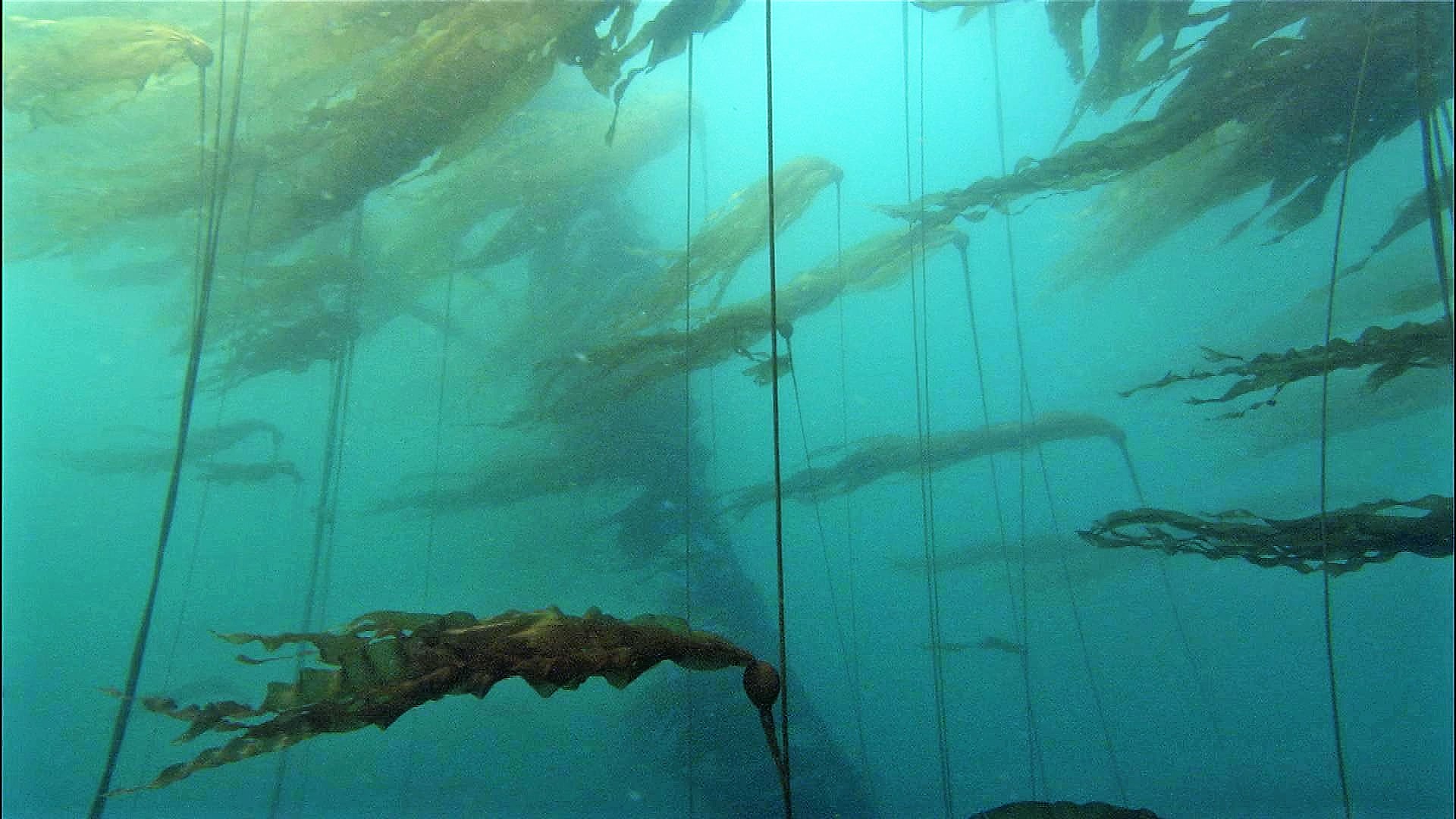
According to Brian Von Herzen, the kelp would receive essential nutrients from deeper cooler water under the sea bed that would circulate over this ‘marine permaculture’. There would be no netting, but a kind of free-range aquaculture based on providing habitat to keep fish on location.
WHAT LIES BEYOND THE ROCKAWAY REEF?
You could say the Rockaway Reef is a stepping stone to the giant geophysical wonders of the ocean. At a mere 413 acres, the Rockaway Reef is a pimple in comparison to the magnificent, dominant underwater canyonlands that lay approximately 200 miles offshore. The gentle slope seaward over the Long Island Platform ten miles out will find depths of approximately one hundred feet. Here, the Christianson Basin is characteristic of pronounced canyon walls and floors.
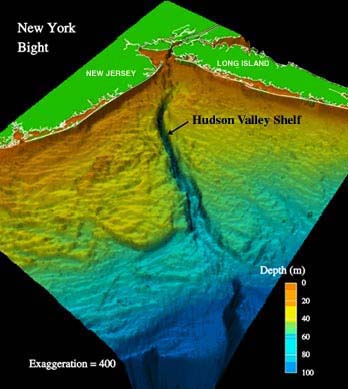
Sadly, this region has not escaped the debilitating effects of toxic dumping that began in the 1920’s. Two massive dumpsites used by New York City twelve nautical miles off the Long Island shore are now still classified as waste cleanup sites by the federal government. A designated fifteen mile radius has been established to correct the original two mile wide ‘Mud Dump’. It is thought the toxins can be ‘capped’ with new dumping of additional ‘clean’ fill. Historic Area Remediation Site officials confirm the sad reality that living shellfish in this region does contain very high levels of PCB’s. Closely supervised monitoring of chemical levels is part and parcel of any chance of redevelopment of this zone as a future habitat for sea life.


The word ‘monument’ designates a ‘no-take zone’, a virgin environment intended not to be disrupted by any commercial venture above or below the surface. This year, the region is in danger of having the Obama enactment reversed by the Trump Administration. Director of the Interior Ryan Zincke stated plans to reopen large-scale commercial mining and fishing. The Trump Administration’s recent Executive Order overturned the Obama Administration’s protection of all Eastern Seaboard canyons to oil, gas, and mining operations.
A CALL OUT TO FISHERMEN, DIVERS, AND VOLUNTEERS
A reliance on local Fishing Associations and the Scuba Diving Community is necessary to highten recreational utilization of artificial reef sites. The New York State Department of Environmental Conservation is banking on the growth of popularity as the engine to continue efforts to responsibly enhance the marine initiatives.
Aside from the obvious increase in fishing boats populating the preserve, the future includes an influx of Dive boats as well as Party Charter boats.
Divers to the Artificial Reef sites are encouraged to fill out the online NYSDEC Volunteer Diver Logs include reasons for their dive such as photography, artifact hunting, spearfishing, or nature study as well as their recent observations from the divers of finding sponges, anemones, mussels, tube worms, or corals as well as sea bass, fluke, crab, or lobster.
A similar NYSDEC Volunteer Angler Log is available for fisherman who would like to report their catch around the artificial reefs to help collect data for NYSDEC.
HOW YOU CAN HELP KEEP THE REEF ALIVE
CLIMATE CHANGE CHALLENGES TO CORAL REEFS
As Ocean waters are heating up, once healthy reefs move further away from the equator. The sad reality is regions that were once thought to be too cold for reefs may now be prime real-estate for new coral reef development.
Climate change is a major factor in the increased water temperatures of tropical reefs is a cause of coral bleaching. The planets’ natural reefs, such as The Great Barrier Reef, is quickly loosing its ability to maintain a thriving habitat. Two mass coral-bleaching events resulting from elevated sea temperatures. Increased acidity can reduce the live coral from building their skeletal habitat.
IS THE FUTURE BRIGHT FOR THE NEW YORK BIGHT?
NYS OEM is also eyeing the New York Bight for Wind Farm development. All government efforts utilize new technology that will move New York into our next generations must require an adherence to maintaining clean water and sustainable marine habitats.
Aside from substantive NYS OEM inroads to the development of Wind Farms in this very region, a thriving artificial reef will attract a renewed population of whales and other ocean mammals. The New York Coast is in the migratory pathways. But, shipping lanes that overlay the underwater migration routes have been wrought with danger.
The Melville buoy has been in service for the past two years. It’s mission is to protect marine mammals from ship strikes as well as reduce ship noise pollution. Alerting sea captains to the presence of whales is of primary importance.
THE RETURN OF THE OCEAN MAMMAL COMMUNITY TO NEW YORK HARBOR
For those interested in spending the day on a local sight-seeing tours by high speed boats can shuttle us out to the canyon areas. Exploration vessels do frequent these waters where research divers presently catalog and film exotic species living in the cold, dark depths of the canyons.
There is no reason why New York City cannot foster a new maritime community of activists and enthusiasts to share and experience the waters with repopulated sea life. We anticipate a healthy whale watching industry right here out of Sheepshead Bay.
COME JOIN US ON MAY 11TH, 2019
NYHC will be hosting a forum at the 69th Street Pier in Bay Ridge Brooklyn. Guest speakers from prominent environmental and conservation societies as well as local science experts will be on hand to help exhibit data and answer questions.
The post WELCOME TO THE ROCKAWAY ARTIFICIAL REEF & BEYOND appeared first on New York Harbor Channel.
]]>